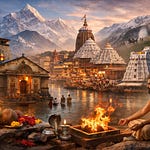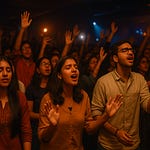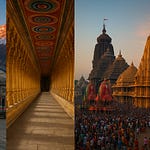Nestled on the banks of the sacred Panchganga River in Kolhapur, Maharashtra, the revered Mahalaxmi Ambabai Temple stands as a magnificent testament to India’s timeless spiritual heritage, rich mythology, and exquisite architectural grandeur. Often regarded as one of India's most powerful and celebrated Shakti Peethas, this temple draws millions of devotees annually, seeking blessings from Goddess Mahalaxmi, the divine embodiment of prosperity, protection, and cosmic power.
Believed to have originated more than 1300 years ago during the flourishing Chalukya era, this sacred shrine resonates deeply within Hindu mythology, where it marks the sacred spot where Goddess Sati's eyes are said to have fallen, imbuing the site with profound spiritual significance. The deity, affectionately worshipped as Ambabai, is venerated as a benevolent mother whose blessings ensure well-being, harmony, and abundance.
Beyond its spiritual eminence, the temple showcases remarkable architectural brilliance, blending the intricate Hemadpanthi style of Maharashtra with subtle influences from Nagara and Dravidian traditions. Every stone carving, majestic shikhar, and ornate pillar tells stories from ancient scriptures and epics, reflecting centuries of devotion and royal patronage. The temple’s unique celestial phenomenon, known as Kirnotsav, when rays of the sun illuminate the divine idol, epitomizes its mystical allure and attracts devotees from across the globe.
As you delve deeper into the vibrant rituals, fascinating legends, architectural details, devotional music, cultural festivities, and practical visitor insights presented here, you’ll uncover the enchanting legacy of the Kolhapur Mahalaxmi Ambabai Temple—a sacred abode where history, devotion, and spirituality merge seamlessly to offer a transformative experience to all who seek refuge at the feet of the divine Mother.
1. Origin & Founding
📖 Historical and Mythological Origins
The Kolhapur Mahalaxmi Ambabai Temple, also known as Shri Mahalakshmi Temple, is one of India's oldest and most revered temples. It is believed to have originated more than 1300 years ago during the Chalukya era, around the 7th century AD.
According to mythology, this temple is among the 18 Maha Shakti Peethas. Legend has it that Lord Vishnu severed Goddess Sati’s body into pieces to pacify Lord Shiva’s grief. The temple is said to have arisen at the spot where Sati’s eyes fell. Therefore, the deity Mahalaxmi Ambabai is deeply associated with cosmic vision, prosperity, and protection.
Connection with Historical Figures:
Mentioned extensively in ancient scriptures such as the Devi Bhagavata Purana and Padma Purana.
Kings from dynasties like the Chalukyas, Rashtrakutas, Yadavas, and later the Marathas patronized the temple extensively.
2. Historical Timeline
📜 Significant Historical Events:
7th century AD: Temple built by the Chalukya dynasty.
10th-11th century: Major renovations by the Shilaharas of Kolhapur.
12th century: Patronage by the Yadava kings; temple flourishes culturally.
1300s-1500s: Survived invasions and remained a spiritual hub despite political instability.
18th century: Maharani Ahilyabai Holkar made significant contributions for renovation and restoration.
📖 Notable Mentions in Texts:
Prominent mentions in Puranas and medieval scriptures.
Described by ancient travelers and poets from Maharashtra and South India.
3. Architecture & Design
🏛️ Architectural Style:
Built primarily in the Hemadpanthi architectural style (a mix of Nagara & Dravidian influences), characterized by intricately carved stone walls and pillars.
🛕 Unique Structural Features:
Shikhar (Temple tower): Majestic structure with intricate carvings and pyramid-shaped dome.
Garbhagriha: Sanctum housing the idol; beautifully decorated and well-lit naturally at certain times of the year.
Sabha Mandap: Hall used for rituals and gatherings, decorated with exquisite stone carvings.
The temple has a distinctive design allowing the sun’s rays to directly illuminate the idol twice a year, during special astronomical alignments (Kiranotsav).
🎨 Sculptures, Murals, and Carvings:
Exquisite stone carvings of gods, goddesses, mythical creatures, and floral motifs.
Ancient inscriptions narrating temple’s history, donations, and renovations.
4. Spiritual Significance
🌟 Why the Temple is Sacred:
Considered as a powerful Shakti Peetha, representing cosmic feminine power.
Believed to bless devotees with prosperity, health, and fulfillment of wishes.
📖 Puranic & Epic Connections:
Linked directly to the legend of Sati and Shiva.
Mentioned in Puranic stories highlighting the glory of the Goddess Lakshmi.
✨ Beliefs & Blessings:
Devotees firmly believe praying here bestows blessings of prosperity, marital harmony, and removes evil energies.
Many come seeking solutions to personal, financial, and health-related problems.
5. Puja & Rituals
🪔 Daily Rituals:
Kakad Aarti (early morning), Madhyana (noon) Puja, Dhoop Aarti (evening), and Shej Aarti (night).
Special abhishekam and alankara rituals conducted regularly.
🙏 Who Performs Rituals:
A hereditary lineage of priests (Pujaris) traditionally performs all rituals.
Families and devotees often sponsor special pujas and seva.
6. Festivals Celebrated
🎉 Major Festivals:
Navratri (Durga Puja) – Grand celebrations attracting massive footfall.
Kirnotsav – When sun rays illuminate the deity’s idol (twice a year: Jan-Feb and Oct-Nov).
Diwali, Ganesh Chaturthi, Mahashivratri, and Lakshmi Pujan also celebrated elaborately.
📅 Peak Footfall Periods:
Navratri and Kirnotsav periods attract pilgrims from all over India.
7. Bhajans & Cultural Aspects
🎶 Traditional Bhajans:
Devotional songs praising Ambabai are sung by devotees daily.
Kirtans and Harikatha (storytelling) sessions regularly held.
🥁 Instruments & Cultural Events:
Traditional instruments like cymbals (Taal), drums (Dholak) accompany bhajans.
Classical music performances and religious discourses often organized.
8. Aarti Timings & Daily Schedule
⏰ Aarti Timings:
Kakad Aarti: 4:30 AM - 6:00 AM
Madhyana Puja: 11:30 AM - 12:30 PM
Dhoop Aarti: 7:00 PM - 8:00 PM
Shej Aarti: 10:00 PM - 10:30 PM
🙌 Best Visiting Time:
Early morning or late evening recommended for peaceful darshan.
9. Special Satsangs, Functions, or Events
🎤 Satsangs & Discourses:
Frequent spiritual discourses conducted by respected gurus and saints.
Annual yatras and large religious gatherings, particularly during Navratri and special astronomical events.
10. Special Pujas & Mystical Beliefs
🔮 Unique Rituals:
Kirnotsav Ritual: Solar alignment illuminating the deity’s idol.
Special abhishekam rituals (milk, water, and panchamrit) during festivals.
🌌 Mysteries & Miracles:
Devotees believe witnessing Kirnotsav fulfills deepest wishes.
Several accounts of healing, miraculous interventions, and divine experiences associated with Ambabai.
11. Devotee Experience
✨ Spiritual Testimonials:
Devotees frequently share transformative experiences, feeling divine energy and peace.
🧑🤝🧑 Crowd Management:
Efficient management of large crowds during festivals.
Queue systems, dedicated volunteer groups, and security in place during peak periods.
12. Travel & Visitor Information
📍 Location & Accessibility:
Kolhapur City, Maharashtra.
Nearest Airport: Kolhapur Airport (9 km)
Railway Station: Kolhapur Railway Station (3 km)
Easily reachable by road from Pune (230 km), Mumbai (375 km).
🏨 Accommodation & Facilities:
Numerous hotels, lodges, and Dharamshalas available nearby catering to all budgets.
Basic facilities including restrooms, restaurants, and shops around the temple.
🚫 Entry Rules & Dress Code:
Traditional attire preferred; modest clothing mandatory.
Shoes, photography (inside sanctum), and leather products strictly prohibited.
🎟️ Guides & Booking:
Guides available locally.
No pre-booking required for normal darshan; special arrangements possible during festivals.
13. Other Details
💰 Donations & Trust:
Managed by the Paschim Maharashtra Devasthan Samiti.
Donations accepted online and offline for temple maintenance and charity works.
🍛 Prasadam & Religious Stores:
Traditional laddu and sweet offerings available.
Numerous religious shops selling devotional items around the premises.
🌐 Online Presence:
Official website offering information, live darshan, and online donation services available.










